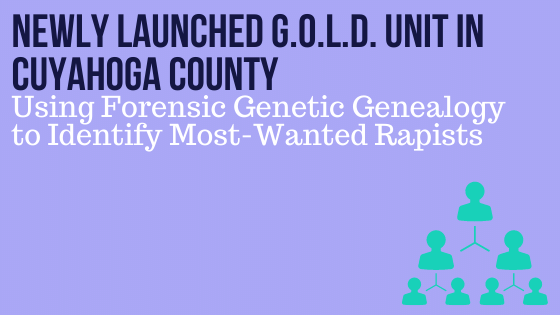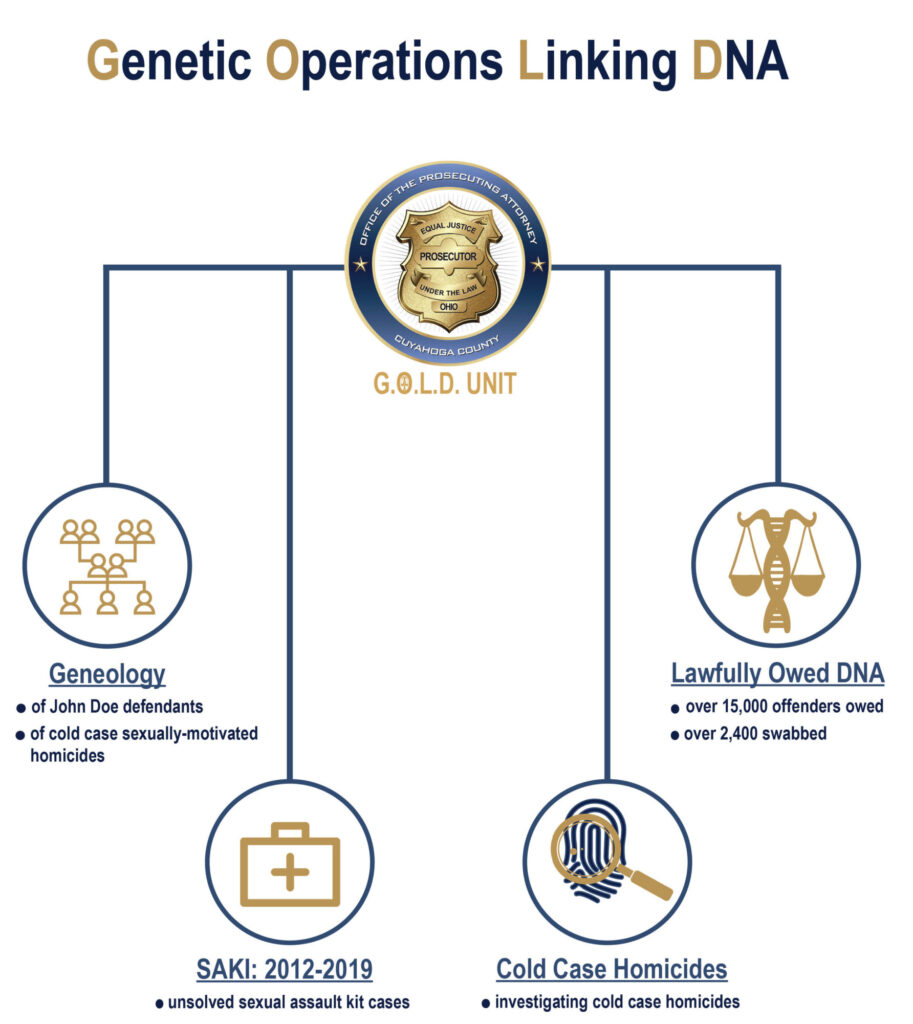In 2013, the Cuyahoga County Prosecutor’s Office (CCPO, Ohio) launched their Sexual Assault Kit Task Force (SAKTF) to investigate leads stemming from the testing of previously unsubmitted rape kits between 1993-2011. Over the years, the Task force finalized over 7,000 investigations which resulted in indictment of 817 defendants and justice for 915 victims.
Last Fall, the CCPO was awarded a $1,000,000 grant from the U.S. Department of Justice to be used towards personnel staffing, victim advocacy and research partnerships, training, and other resources. This grant, in combination with prior DOJ funding helped to launch the office’s Genetic Operations Linking DNA (G.O.L.D.) Unit, which will allow the CCPO to expand their efforts by utilizing forensic genetic genealogy.
Since the identification of the Golden State Killer in 2018, forensic genetic genealogy techniques have proven to be a powerful tool in closing cold cases and restoring identities to unidentified remains cases. Forensic genetic genealogy relies on genetic relationships between a DNA profile for an unknown person and profiles of known people in genealogy databases, such as GEDmatch, FamilyTreeDNA, or DNASolves. To begin, investigators upload their unknown DNA profile to the site, which generates a list of the closest genetic matches, based on how many centimorgans (cM) of DNA are shared with the unknown person. Next, investigators will begin to build back the unknown person’s family tree until a common ancestor is uncovered. Then, they will build the family trees forward, identifying every descendent possible, using traditional genealogy techniques. Once the trees have been fully built out, investigators look to identify candidate person that might match the unknown person. Once a person of interest has been identified, new DNA can be collected to compare to the original forensic sample.
To learn more about how the G.O.L.D. Unit is using forensic genetic genealogy to identify some of their most-wanted cold case rapists, we interviewed Mary Weston, Unit Supervisor of the Cold Case G.O.L.D. Unit (Genetic Operations Linking DNA) and project manager for the Cuyahoga County Sexual Assault Kit Taskforce (SAKTF). In her role, Mary oversees the unit which investigates and prosecutes sexual assaults and cold case homicides, consisting of prosecutors, investigators, victim advocates, and professional staff.
Mary, thank you for talking with us today. I understand that CCPO has enjoyed great success with the Sexual Assault Kit Task Force that was formed several years ago. Since 2013 investigations from this team have resulted in 817 defendants indited with a 93% conviction rate. Given this success, what was the impetus for forming the GOLD unit?
The most updated numbers we have include the following:
- 7,026 investigations completed
- 830 defendants indicted (the highest number of any SAKTF in the country)
- 930 victims (several defendants are convicted or alleged serial offenders)
- 3% conviction rate
Despite the success the Cuyahoga County SAKTF has had in solving and prosecuting hundreds of violent crimes, several brutal attacks still remain unsolved. In the past, we have utilized the Combined DNA Index System (CODIS) – the FBI’s national DNA database – and other resources to solve cold cases. However, we have learned that additional tools, like genealogical databases, can be used to identify serial offenders that are not being identified by CODIS. The CODIS database is limited by its entries – it only consists of DNA profiles from felony offenders. That means a whole population of rapists – those who have never been arrested or convicted – remain “hidden” and their crimes remain unsolved. It is imperative that we take advantage of as many resources as possible to ensure justice for victims and protect our community from further harm.
Who are the other members of the Genetic Operations Linking Data (GOLD) Unit?
Prosecutors, investigators, victim advocates, and professional staff, as well as partnerships with the Cleveland Division of Police (CPD), Case Western Reserve University (CWRU), Cuyahoga County Medical Examiner’s Office (CCMEO), Ohio Bureau of Criminal Investigation (BCI), Cuyahoga County Sheriff’s Office (CCSO), and Cleveland Rape Crisis Center (CRCC).
What are the goals of this new unit?
The Unit’s goals include the following:
- Leverage DNA resources to solve previously unsolved crimes to ensure we are holding offenders accountable and preventing future crimes within our community.
- Infuse our data and knowledge with scholarly research that can be disseminated to create a broader understanding of DNA importance and crime prevention, and provide guidance to other jurisdictions looking to start a sexual assault kit taskforce or cold case unit;
- Use said research to educate law enforcement agencies and other government entities about the importance of collecting DNA
- g. when DNA collection is missed it has led to numerous instances of serial offenders who have gone on to commit other offenses – this obviously not only harms additional victims, but it leads to additional economic harm to the community as law enforcement resources will have to be used to follow-up on each additional crime
- The Unit’s work will include:
- Expanding our SAKI investigations
- Initially we focused on addressing investigative leads from testing previously unsubmitted rape kits between 1993 and 2011
- We now are expanding that to include sexual assault kits that were submitted by CPD to the CCMEO for testing between 2012 and 2019 that need further investigation or testing;
- Genealogical testing of cold case sexual assaults
- We have selected our “20 Most Wanted DNA Profiles” for the initial pilot project with the genealogical company
- Genealogical testing of cold case sexually-motivated homicides
- In 2020, we received a grant through the DOJ Bureau of Justice Assistance that allows us to use funds to pay for genealogy on unsolved homicides that are sexually-motivated. We are currently reviewing unsolved sexually-motivated homicides for suitability for genealogy testing.
- Continuing the Lawfully Owed DNA project
- Continue to collect DNA on those offenders who lawfully owe it to law enforcement
- Out of the 15,371 offenders we have identified who lawfully owe DNA, we have swabbed 2,441 to date – 87 of which produced a CODIS “hit” to another crime (including murder, sexual assault, robbery, & others)
- Expanding our SAKI investigations
Why did you elect to use an outside company to process these cases instead of using in-house resources?
Our office currently does not have those capabilities as we do not have access to genealogy databases that the public has put their DNA into. Up until now, if we identified a DNA profile on a piece of evidence, the best we could hope for was that the profile was eligible to be uploaded to the CODIS database. However, the CODIS database is limited because it only consists of DNA profiles from felony offenders. Now, with this new funding, we will expand our pool of DNA profiles to catch these previously “hidden’ offenders through genealogy.
How will you decide which cases the unit will work first?
The CCPO formed a committee of prosecutors and investigators with the aim of producing a list of 20 indicted John Doe defendants most suitable for investigative genetic genealogy. The committee went through an extremely thorough vetting process in which it reviewed all the Task Force’s indicted John Doe cases and ranked them, considering such factors as (a) whether the unknown DNA profile was linked to multiple crimes (i.e. serial offenders); (b) DNA results (i.e. the quality and quantity of the DNA); and (c) the facts of the case (i.e. the case’s solvability in the event genealogy produced results, including witness availability). The CCPO wanted to ensure that if genealogy solved the case, the case would be immediately highly prosecutable.
Have any challenges arisen during the creation of the GOLD unit? How did you overcome these challenges?
Your instinct is that you want to submit all of your unsolved cases for genealogy to bring justice for every single victim. However, genealogy is cost-prohibitive. In 2019, we applied for and received a grant from the Department of Justice’s Bureau of Justice Assistance Programs Sexual Assault Kit Initiative. The grant provided enough funding for us to submit 20 unsolved sexual assault cases for genealogy. To overcome the challenge of limiting our pool to 20 cases, we focused on which cases involved unidentified serial offenders and which involved the most violent crimes. Solving these cases first will make our significantly community safer and bring justice for these victims. We are grateful that in 2020, we applied for and received funding that we will use to test even more cases.
What advice do you have for other jurisdictions considering implementing genetic genealogy?
Set up a committee to review the largest pool of cases that can be considered for genealogy. Look at your lab reports and determine suitability for genealogy based on location of the DNA on the evidence and whether the DNA is single source or a mixture. Review the facts of the case and make sure parties are still available to determine the case’s solvability if genealogy produces results. You want to ensure that if genealogy solves the case, the case will result in a successful prosecution.
Does the task force have an expiration date, or will it continue as long as it produces results?
We are committed to continuing this project for as long as we can. As long as there are cases that need to be solved and victims that are waiting for justice, we will continue to seek funding so we can hold these “hidden” offenders accountable.
Have any of your cases already been solved through use of genetic genealogy?
Not yet. We are very excited to announce that we have shipped our first batch of cases to our genealogy lab and are awaiting results. These cases are all unsolved “John Doe” rape cases, meaning a grand jury has returned an indictment against a DNA profile that represents the rapist, but the person with that DNA profile has not yet been identified.
Can you describe the details of some of the cases that you are hoping to solve through genetic genealogy?
We cannot discuss the particulars of any open investigations, but we can say that our first batch of genealogy cases represents our unsolved serial offenders and most violent stranger rapes.
WOULD YOU LIKE TO SEE MORE ARTICLES LIKE THIS? SUBSCRIBE TO THE ISHI BLOG BELOW!
SUBSCRIBE NOW!



